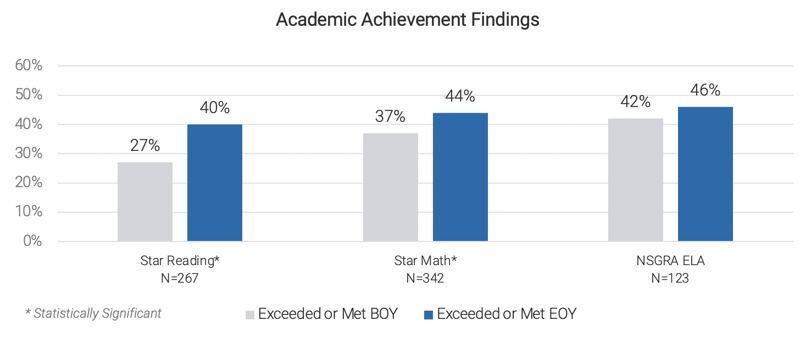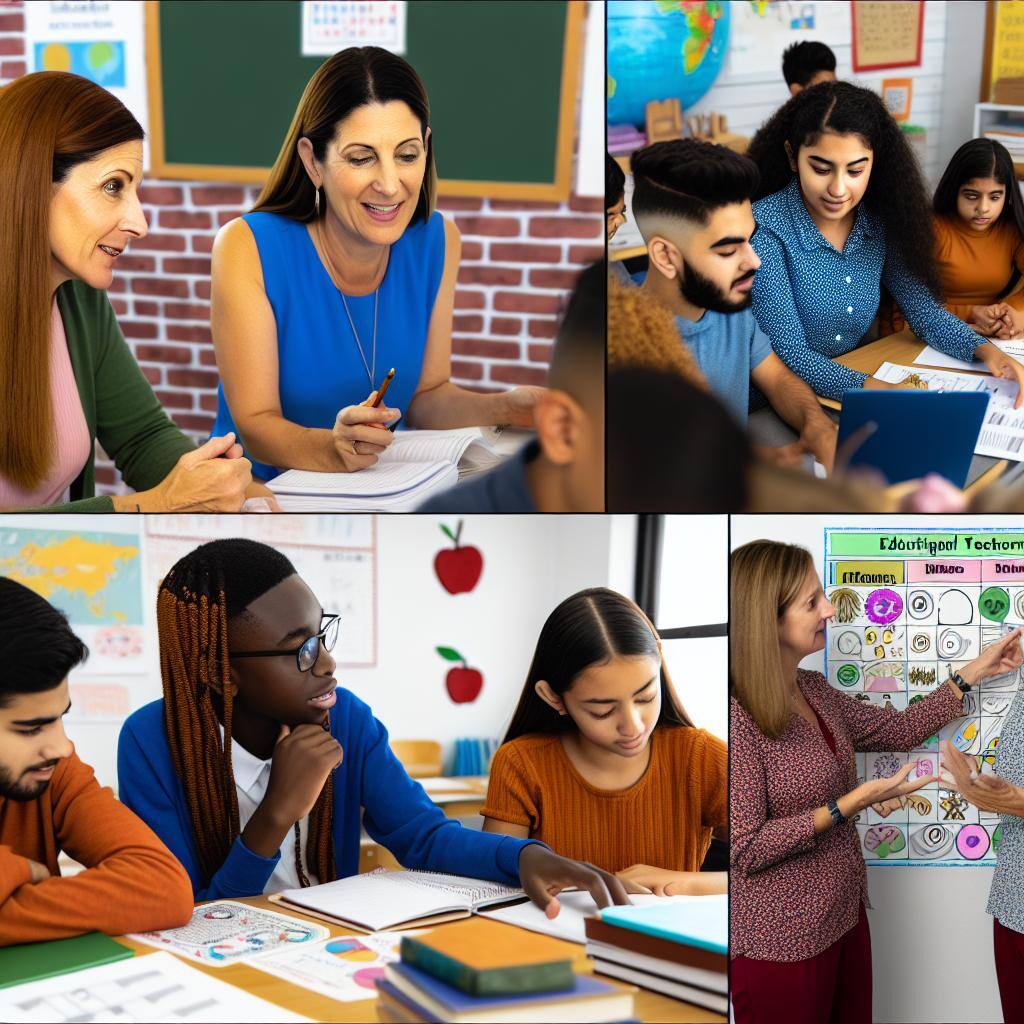Impact of PowerMyLearning’s Social Emotional Learning Program
2021-2022 School Year Analysis
by Katie James, Ph.D., Director of Research and Neha Pandit, Senior Manager of Research and Program Operation
Abstract
This study examined whether PowerMyLearning’s Social Emotional Learning (SEL) program improved student and teacher SEL competencies as well as aspects of academic achievement during the 2021-2022 school year. This program is one of many offered by PowerMyLearning that leverages the Triangle of Learning—a unique approach that has been refined and studied over the last few decades. The results of this study indicate that PowerMyLearning’s SEL program was related to significantly better student SEL skills, teacher confidence in supporting SEL, teacher-family relationships, and school climate. The program was also associated with significant differences in math and reading achievement.

Students had significantly better self-efficacy (+12%; p<.10) and self-management (+7%; p=.08) after the program. In addition, teachers were significantly more confident in supporting students’ SEL, including self-efficacy (+11%; p<.10), sense of belonging (+10%; p<.10), and sense of safety (+11%; p=.08) after the program. The study also showed significant improvements in teacher-family relationships (+13%; p<.01) and school climate (+7%; p=.03).

Research Context
This study examined the impact of our SEL program called “Nurture Student Growth Through Social Emotional Learning (SEL)” on grade 1-6 teachers, students, and families at one partner school in San Jose, California during the 2021-2022 school year. The student demographics of this school were 67% Hispanic, 29% Asian American and Pacific Islander (AAPI), with 78% of students qualifying for free or reduced lunch.
In the prior year, the school delivered instruction remotely in response to the pandemic. The school was eager to focus on SEL during the 2021-2022 school year to address behavioral and interpersonal challenges that arose when students returned to in-person instruction. During the 2021-2022 school year, 26 educators, including K-6 teachers and other school staff and leadership, participated in the program with a total reach of 523 students. This study focuses on data collected from 18 grades 1-6 teachers. Details of the study and our impact are provided in the research methods section of this report.
PowerMyLearning SEL Program
The elements of the “Nurture Student Growth Through Social Emotional Learning (SEL)” program are designed to complement each other and to build capacity for both teachers and families by leveraging best practices for adult learners. We intentionally include families in the program because working with the adults closest to students (teachers as well as caregivers) enables these adults to reinforce each other’s efforts. Our workshops for teachers are always followed by small group coaching to extend learning into daily practice because this design has been shown to have the greatest impact.
In the 2021-2022 school year, the partner school received the following:
-
- Four Educator Workshops for 26 teachers, leadership and other school staff. The workshops were designed to provide strategies for interpreting and addressing challenging behaviors in and out of the classroom, as well as for building an inclusive community of motivated learners. Workshop titles included: Trauma-Informed Practices that Benefit All Learners, Mindfulness and More for Kids and Adults, Build a Classroom Community Where All Student Feel They Belong, and Transform Discipline into a Learning Opportunity.
- Coaching for 18 teachers in grades 1-6 to extend learning from the first three Educator Workshops into daily practice. Each teacher participated in three cycles of three coaching sessions (nine total sessions). Coaching sessions were 45 minutes each, resulting in 6.75 coaching hours per teacher.
- Four 60-minute Family Workshops delivered in Spanish and English that were designed to provide strategies for families to support their children’s well-being, as well as their own. Workshop titles included: Self-Care for Family Wellness, Strategies to Foster Your Child’s Motivation, Navigate Cyberbullying and Social Media, Understanding Your Child’s Developmental Milestones.
Research Methods
In this section, we will describe the design, instruments, data analysis, and study results. We will then discuss the implications and limitations of the results and next steps of this work.
Design
We used a pre-post study design to examine PowerMyLearning’s impact on SEL competencies and academic achievement. SEL survey data was collected from 18 teachers in grades 1-6 in October (pre) and March (post). Academic achievement data was collected from 342 students in grades 1-6 at the beginning and end of the school year.
Instruments
SEL Survey. Teachers completed a 20-question SEL survey adapted from the Panorama teacher survey PowerMyLearning researchers modified the original survey to incorporate questions related to additional hypothesized outcomes, including teachers’ perceptions of school safety and students’ sense of belonging. In addition, we adapted questions from the Panorama SEL survey to pertain to the whole class, rather than individual students, and we added questions to the survey to examine teacher perceptions of student SEL competencies. Thus, the SEL survey included questions about student SEL competencies, teacher confidence in supporting SEL, teacher-family relationships, and school climate. The SEL competencies included self-efficacy, growth mindset, self-management, and social awareness. The teacher confidence questions focused on supporting those same student SEL skills.
Academic Assessments. Academic achievement data was based on school-administered achievement tests. The assessments include Renaissance Star Reading (grades 2-6; N=267), Renaissance Star Math (grades 1-6; N=342), and Next Step Guided Reading Assessment (NSGRA) (grades 1-3; N=123). The reading test data were norm-referenced scores that provide an indicator of students’ reading level (Instructional Reading Level for Star Reading and Scholastic Reading Level for NSGRA). The Star Math data were norm-referenced grade equivalent scores.
Data Analysis
SEL Survey Analysis. Responses to each survey question were scored on a 5-point scale. In cases where multiple survey questions pertained to the same SEL construct, such as teacher-family relationships, the individual question scores were averaged to create an overall score for that construct. We then conducted paired samples t-tests on the pre/post-data for each of the SEL constructs.
Academic Assessment Analysis. We evaluated beginning of year student data relative to the beginning of year district benchmarks for each assessment. We evaluated end of year student data relative to the end of year district benchmarks for each assessment. We analyzed whether each student exceeded or met the relevant district benchmark for each assessment at each timepoint, resulting in categorical data. We then conducted McNemar’s tests on the beginning and end of year data for each assessment. We also calculated the percent of students who exceeded or met the relevant district benchmark for each assessment at the beginning and end of the year.

Discussion
PowerMyLearning is committed to building evidence around the impact of our work. This study found statistically significant impact of PowerMyLearning’s “Nurture Student Growth Through Social Emotional Learning (SEL)” program on multiple aspects of SEL. The program was also associated with significant differences in math and reading achievement. The findings indicate that the SEL program successfully supports students’ SEL competencies, teachers’ confidence in supporting SEL, and the development of positive teacher-family relationships and school climate, which are key goals of the program. One limitation of this study is that several of the SEL constructs were based on a single survey question. Another limitation is that the results reflect the impact of all learning experiences during the 2021-2022 school year and cannot be solely attributed to the SEL program. Additional data with more robust instruments will be collected to corroborate the results of this study. Randomized controlled trials will also be conducted to examine the impact of PowerMyLearning’s programs compared to a control group, which will enable us to more precisely determine the extent to which our programs are causing observed effects.
Download a PDF of PowerMyLearning’s Impact Study
Access new, expanded case study about PowerMyLearning's SEL program at Meadows.
Acknowledgements
This study was generously funded by the Leon Lowenstein Foundation.


